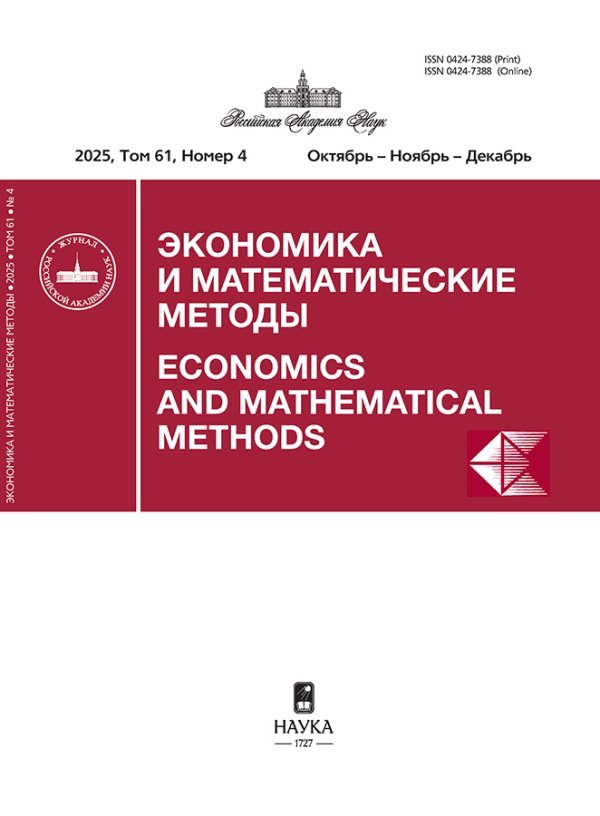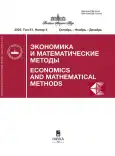Objective and subjective factors in stock index dynamics
- Authors: Andrukovich P.F.1
-
Affiliations:
- Central Economics and Mathematics Institute, Russian Academy of Sciences
- Issue: Vol 61, No 4 (2025)
- Pages: 5-17
- Section: World economy
- URL: https://stomuniver.ru/0424-7388/article/view/697026
- DOI: https://doi.org/10.31857/S0424738825040017
- ID: 697026
Cite item
Abstract
This article analyzes the dependence of stock index dynamics on two types of factors — objective and subjective — which are understood, on the one hand, the dynamics of economic development, and, on the other hand, the activities of various stock market participants, affecting both the dynamics of the entire stock market and the values of stock indices. At the beginning of the article, the structure of the ratios of these factors is considered, and a summary of the content of the article is given. It is assumed that the main trend in the dynamics of the stock index, represented by the regression model, characterizes the results of objective factors, and deviations from it — subjective factors. After reviewing the works devoted to the construction of regression models for various stock indexes, a brief description of the history of the creation of the most famous stock index, the Dow–Jones index, is given. Based on the dynamics of this index for 1897–2024, regression models describing its main trend are built and the deviations of the index from this trend are analyzed. It is assumed that this trend depends on the objective characteristics of economic development, and deviations from it depend on the influence of subjective factors. It is shown that the main reasons for these deviations are incorrect time and intensity changes in the list of companies for which it is calculated, made by the managers of the index. This is interpreted as the influence of such a subjective factor as the “human factor” on the dynamics of this index. The level and significance of these deviations are further assessed against the background of the dynamics of US GDP, and it is shown that although in some periods of time the “human factor” deviates the dynamics of the index from the dynamics of US GDP, in general, the dynamics of the US economy has some “attractive force” for the dynamics of the Dow–Jones index. In conclusion, it is noted that when constructing models of stock indices, it is necessary to take into account the specific features of their structure, including the principles of changing their lists, the role of coefficients in the formulas for calculating these indices, and their other characteristics.
Keywords
About the authors
P. F. Andrukovich
Central Economics and Mathematics Institute, Russian Academy of Sciences
Email: streletspa@yandex.ru
Moscow, Russia
References
- Андрукович П. Ф. (2005). Долгосрочная и среднесрочная динамика индекса Доу–Джонса // Проблемы прогнозирования. № 2. С. 46–62. [Andrukovich P. F. (2005). Long-term and medium-term dynamics of the Dow–Jones index. Studies on Russian Economic Development, 2, 46–62 (in Russian).]
- Андрукович П. Ф. (2016). О двойственной роли корректирующего коэффициента в формуле расчета индекса Доу–Джонса // Экономическая наука современной России. № 3 (74). С. 30–42. [Andrukovich P. F. (2016). On the dual role of the correction factor in the formula for calculating the Dow–Jones index. Economics of Contemporary Russia, 3 (74), 30–42 (in Russian).]
- Андрукович П. Ф. (2017). «Человеческий фактор» в истории изменений списков индекса Доу–Джонса // Экономическая наука современной России. № 3 (78). С. 137–154. [Andrukovich P. F. (2017). The “human factor” in the history of changes in the lists of the Dow–Jones index. Economics of Contemporary Russia, 3 (78), 137–154 (in Russian).]
- Андрукович П. Ф. (2019). Динамика котировок акций при их листинге и делистинге // Журнал Новой экономической ассоциации. № 4 (44). С. 50–76. [Andrukovich P. F. (2019). Dynamics of stock quotations during their listing and delisting. Journal of the New Economic Association, 4 (44), 50–76 (in Russian).]
- Андрукович П. Ф., Лепетиков Д. В. (2024). Несколько историй из жизни индекса Доу–Джонса. М.: ЦЭМИ РАН. 148 с. [Andrukovich P. F., Lepetikov D. V. (2024). Several stories from the life of the Dow Jones index. Moscow: CEMI RAS. 148 p. (in Russian).]
- Бердникова Т. Б. (2013). Рынок ценных бумаг: прошлое, настоящее, будущее. М.: Инфра-М. 397 с. [Berdnikova T. B. (2013). The securities market: Past, present, and future. Moscow: Infra-M. 397 p. (in Russian).]
- Егорова Н. Е., Бахтизин А. Р., Торжевский К. А. (2021). Прогнозирование фондовых рынков с использованием экономико-математических моделей. М.: URSS. 248 с. [Egorova N. E., Bakhtizin A. R., Torzhevsky K. A. (2021). Forecasting stock markets using economic and mathematical models. Moscow: URSS. 248 p. (in Russian).]
- Егорова Н. Е., Торжевский К. А. (2015). Модели и методы анализа фондовых рынков и опыт их применения в условиях России // Экономика и математические методы. Т. 51. № 1. С. 68–79. [Egorova N. E., Torzhevsky K. A. (2015). Models and methods of stock market analysis and the experience of their application in Russia. Economics and Mathematical Methods. 51 (1), 68–79 (in Russian).]
- Кузовкин А. И., Стакун А. В. (2018). Динамика фондового индекса Доу–Джонса в зависимости от ВВП, корпоративной прибыли и цены на нефть в экономике США // Микроэкономика. № 3. С. 68–78. [Kuzovkin A. I., Stakun A. V. (2018). The dynamics of the Dow–Jones stock index as a function of GDP, corporate profits and oil prices in the US economy. Microeconomics, 3, 68–78 (in Russian).]
- Теплов С. Е. (2007). R/S анализ американского фондового, российского фондового и валютного рынков. В сб.: «Финансовый сектор в экономике». М.: МФПА. [Teplov S. E. (2007). R/S analysis of the American stock, Russian stock and foreign exchange markets. In: “The financial sector in the economy”. Moscow: MFIA (in Russian).]
- Цыпин А. П. (2016). Сравнительный статистический анализ динамики индексов Доу–Джонса и ММВБ // Системное управление. № 1 (46). С. 46–55. [Tsypin A. P. (2016). Comparative statistical analysis of the dynamics of the Dow–Jones and MICEX indices. System Management, 1 (46), 46–55 (in Russian).]
- Adebayo F. A., Sivasamy R., Shangodoyin D. K. (2014). Forecasting stock market series with Arima model. Journal of Statistical and Econometric Methods, 3 (3), 65–77.
- Affleck-Graves J.F. (1977). The application of multivariate statistical techniques in the analysis of stock market data. Cape Town: University of Cape Town.
- Arias M., Arratia A., Xuriguera R. (2013). Forecasting with Twitter data. ACM transactions on Intelligent Systems and Technology, December, 1–25. doi: 10.1145/2542182.2542190
- Bahrammirzaee A. (2010). A comparative survey of artificial intelligence applications in finance: Artificial neural networks, expert system and hybrid intelligent systems. Neural Computing and Applications, 19 (8), 1165–1195.
- Bhandari H. N., Rimal B., Pokhrel N. R., Rimal R., Dahal K. R., Khatri R. K.C. (2022). Predicting stock market index using LSTM. Machine Learning with Applications, 9 (15), 2–15.
- Bollen J., Mao H., Zeng X. (2011). Twitter mood predicts the stock market. Journal of Computational Science, 2 (1), 1–8.
- Cao J., Wang J. (2020). Exploration of stock index change prediction model based on the combination of principal component analysis and artificial neural network. Soft Computing, 24 (1), 7851–7860. doi: 10.1007/s00500-019-03918-3
- Duarte F. B., Machado J. T., Duarte G. M. (2010). Dynamics of the Dow–Jones and the NASDAQ stock indexes. Nonlinear Dynamics, September, 1–17. doi: 10.1007/s11071-010-9680-z
- Enke D., Grauer M., Mehdiyev N. (2011). Stock market prediction with multiple regression, fuzzy type-2 clustering and neural networks. Procedia Computer Science, 6 (8), 201–206. Available at: https://www.sciencedirect.com/science/article/pii/S1877050911005035
- Fama E. F. (1965). The behavior of stock-market prices. The Journal of Business, 38 (1), 34–105.
- Franke J., Härdle W.K., Hafner C.M. (2008). Statistics of financial markets: An introduction. 2nd ed. N.Y.: Springer. 498 p. ISBN: 978–3–540–76269–0; doi: 10.1007/978-3-540-76272-0
- Ghiassi M., Skinner J., Zimbra D. (2013). Twitter brand sentiment analysis: A hybrid system using N-gram analysis and dynamic artificial neural network. Expert Systems with Applications, 40 (16), 6266–6282.
- Handbook of Financial Time Series (2009). T. G. Andersen, R. A. Davis, J. P. Kreiss, T. Mikosch (eds.). N.Y.: Springer. 1050 p. doi: 10.1007/978-3-540-71297-8
- Hansen P. R., Huang Z., Shek H. H. (2011). Realized GARCH: A joint model for returns and realized measures of volatility. Journal of Applied Econometrics, 27 (6), 877–906. doi: 10.1002/jae.1234
- Jin R., Wang Sh., Yan F., Zhu J. (2015). The application of ARIMA model in 2014 shanghai composite stock price index. Journal of Applied Mathematics and Statistics, 3 (4), 199–203.
- Seethalakshmi R. (2018). Analysis of stock market predictor variables using linear regression. International Journal of Pure and Applied Mathematics, 119 (15), 369–378.
- Sprenger T. O., Tumasjan A., Sandner P. G., Welpe I. M. (2013). Tweets and trades: The information content of stock microblogs. European Financial Management, 20 (5), 926–957. doi: 10.1111/j.1468-036x.2013.12007.x
- Stockhammar P. (2010). Comovements of the Dow–Jones stock index and US GDP. Research Report, 2, 1, 1–29. Stockholm University, Department of Statistics.
- Suharsono A., Ahmad I. S., Wibisono A., Pramesti W. (2018). Modeling of autoregressive moving average and vector autoregressive for forecasting stock price index in ASEAN countries. International Journal of Mechanical Engineering and Technology, 9, 309–319.
- Taran R. (2022). Stock market analysis using linear regression. Proceedings of the Jepson Undergraduate Conference on International Economics, 4, Article 4, 1–7.
- Wilkens S. (2022). Predicting stock index changes. The Journal of Portfolio Management, 48, 7, 175–194.
- Yan K., Gupta R., Haddad S. (2022). Statistical analysis Dow–Jones stock index — cumulative return gap and finite difference method. J. Risk Financial Management, 15 (89), 1–44. doi: 10.3390/jrfm15020089
Supplementary files











